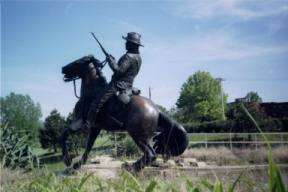Buffalo Soldier Monument
category : Monuments
 The Buffalo Soldier Monument, the brainchild of General Colin Powell, is a recent addition to Fort Leavenworth's historic landmarks. Dedicated in 1992, the monument honors the African-American soldiers who served in the 9th and 10th Cavalry Regiments.
The Buffalo Soldier Monument, the brainchild of General Colin Powell, is a recent addition to Fort Leavenworth's historic landmarks. Dedicated in 1992, the monument honors the African-American soldiers who served in the 9th and 10th Cavalry Regiments.They fought valiantly for their country and many died in the colors of the U.S. Cavalry. Yet they are the most unrecognized and deserving of all American Military Units.
The History of Buffalo Soldier
The name "Buffalo Soldier" originated from Native American Indians who found a similarity between the Trooper's hair and that of buffalo fur. These soldiers showed courage and bravery during the
battles they fought with the Indians, earning their respect.
These distinguished soldiers are an integral part of the rich heritage found embedded in the history of the United States, the State of Kansas and the U.S. military. During the years following the Civil
War, the advancing endeavors of the pioneers were dependent upon the courageous actions of the Ninth & Tenth U.S. Cavalry for their protection. They fought every type of hostile Indian, bandit, cattle thief, murderer, gunman, bootlegger, trespasser and Mexican revolutionary. From Kansas, they extended their protection southward to the Rio Grande, westward to the mountains and northward to Canada.
It was the buffalo soldier that scouted under great hardships, to guard the lives of the early settlers who came with their families to develop this region into farms and cities. The meager and embryonic law enforcement existing in these small isolated communities would have had little chance of success without the presence of the black soldiers. For it was they who fought and took the most difficult and dangerous action against groups of frontier ruffians.
The only hardships not overcome by the black soldiers in the early days of the two regiments were the racial discrimination and prejudicial treatment. The Ninth and Tenth Cavalries were consistently issued inferior horses, equipment, rations and living quarters. What was not of inferior quality was of insufficient quantity. In spite of these hardships and the difficult mission, these soldiers compiled an enviable record of accomplishments and victories. Their ranks included sixteen Medal of Honor
recipients.
On December 1, 1888, General Benjamin Grierson, upon relinquishing command of the Tenth Cavalry stated;
"Always in the vanguard of civilization and in contact with the most warlike and savage Indians of the Plains. The officers and men have cheerfully endured many hardships and privations, and in the midst of great dangers steadfastly maintained a most gallant and zealous devotion to duty, and they may well be proud of the record made, and rest assured that the hard work undergone in the accomplishment of such important and valuable service to their country, is well understood and
appreciated, and that it cannot fail, sooner or later, to meet with due recognition and reward."
Come visit us in Fort Leavenworth, Kansas